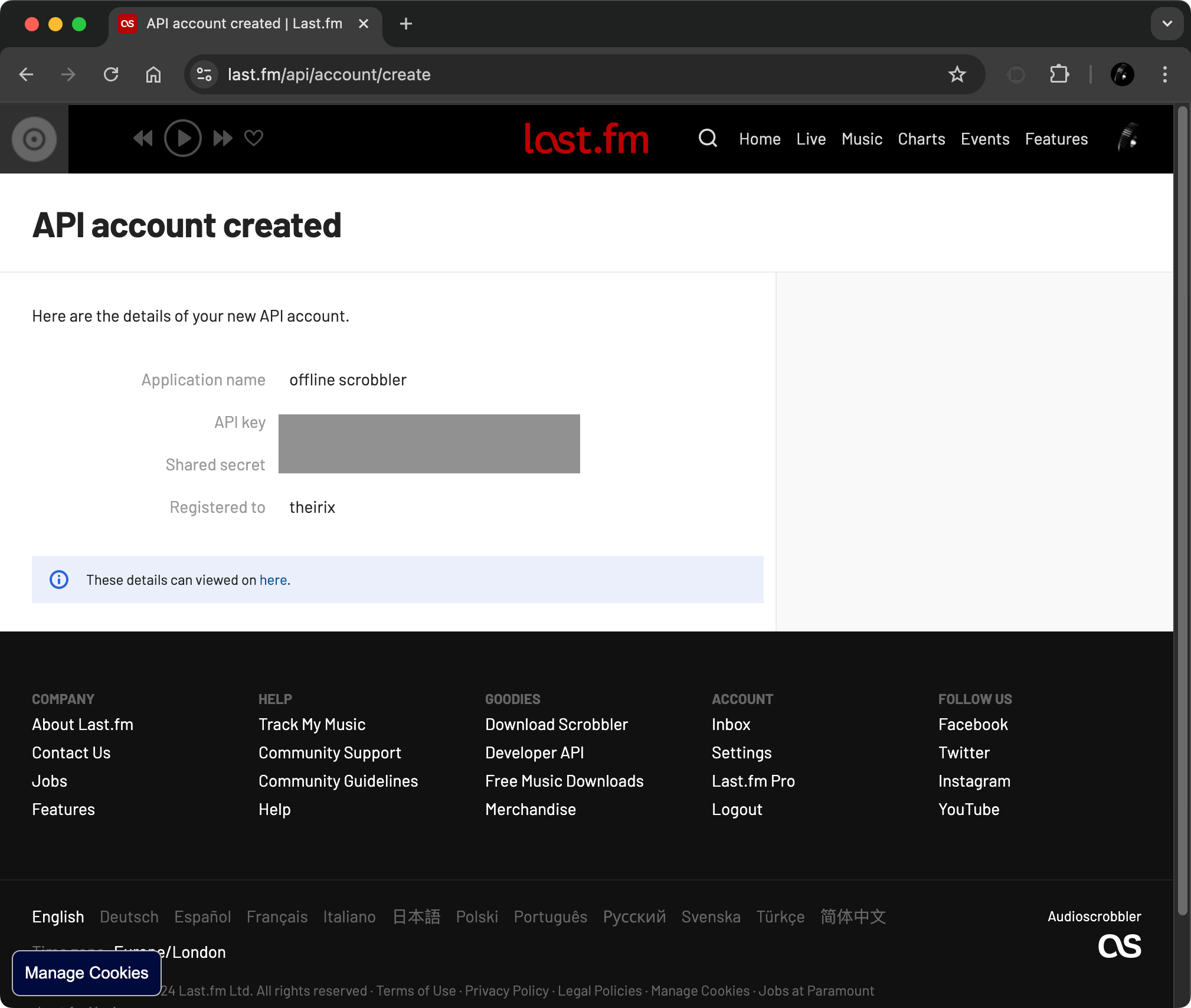27 Aug 2024
 Image by M. Johnson under CC BY 2.0
Image by M. Johnson under CC BY 2.0
Imagine: you are sitting in a comfy chair near your stereo system, smelling the scent of a vinyl record spinning on your turntable, looking at the artwork, and listening to music. Is there something you might have forgotten to do?
It is not a problem at all since Last.fm allows you to scrobble using its API. That’s how your scrobblers for desktops and mobile devices work. So, I wrote a utility called offline-scrobbler to scrobble music to Last.fm for a given artist and album.
How to set it up
Install the utility. The simplest way to do it, if you have Cargo installed, is to run:
cargo install offline-scrobbler
GitHub releases contain Linux binaries. They are automatically built for Linux using musl to avoid problems with glibc linkage. Building macOS and Windows executables is a little more challenging. If anyone wants them, please ping me.
You need to create a Last.fm application account. Since this scrobbler is not a public service and it just runs on your machine, you need to create an account for yourself. Head to Last.fm, and log in as usual. Then go to Create API account page. Here, you need to enter your “Contact e-mail”, an arbitrary name to “Application name” field, and nothing more.

On the next screen, you will be presented with unique account keys for this application. Write down the “API Key” and “Shared secret”.

Provide the keys to the utility with the following call:
offline-scrobbler auth --api-key API_KEY --secret-key SHARED_SECRET
You are all set!
Scrobbling music
That’s why we are here, right?
I supported three typical scrobbling scenarios.
First of all, scrobble one song. It’s pretty easy:
offline-scrobbler scrobble --artist=Hooverphonic --track=Eden
Then, you can scrobble the whole album:
offline-scrobbler scrobble --artist=Hooverphonic --album="A New Stereophonic Sound Spectacular"
Finally, if you have a Last.fm album page open, just grab the URL and feed it to the scrobbler:
offline-scrobbler scrobble-url --url "https://www.last.fm/music/Hooverphonic/Blue+Wonder+Power+Milk"
Internals
Did I mention that the scrobbler is blazingly fast 🚀 because it is written in Rust 🦀 ? :)
The scrobbler relies on Last.fm artist and album names. So, it’s advisable to first run scrobbler in preview mode (--dryrun argument) to verify you’re scrobbling precisely the tracks you want. If there are any scrobble problems or tracks are ignored, they will be reported to the console.
I was surprised that Rust is missing a good scrobbler library. Anyway, it is a common problem. I wrote mine in Objective C while developing a desktop scrobbler for OS X a decade ago. The reqwest and serde simplify writing API clients a lot. Unfortunately, last.fm / audioscrobbler API is XML-based, so you have to write some boilerplate.
The core types for scrobbling logic are pretty simple:
#[derive(Debug)]
pub struct Track {
pub title: String,
pub duration: i64,
}
#[derive(Debug)]
pub struct Album {
pub title: String,
pub tracks: Vec<Track>,
pub url: Option<String>,
}
All the error handling logic is nicely supported by anyhow (for propagating errors in CLI application) and thiserror (to model library error enum).
Writing CLI applications in Rust is a breeze. Combining clap, serde and env_logger is one of the finest ways to make a complicated CLI with parameter groups, validation, colour handling and other nice things. The only unfortunate thing I’ve noticed is that authors of clap v4 recently decided to unconditionally drop colour support in favour of more generic ANSI underlining. Let’s check the state of this issue.
Date and time
One curious thing I’ve discovered is that std library doesn’t provide formatters for std::time::Duration. It has Debug trait implementation, but the formatting is excluded explicitly because: “there are a variety of ways to format periods for human readability”. So, one should use an implementation from chrono or time. The time crate has a totally different Duration type apart from std, which is not so convenient. Finally, there are ongoing debates which external datetime library to use. Maintainers of chrono returned to support the crate, and one more library called jiff just arrived from BurntSushi, so the choice became even harder. The main downside of a well-supported and lightweight time crate for me is the lack of strftime-style format. It is so ubiquitous to use %H-%M-%S instead of
time.format(format_description!("[hour]:[minute]:[second]"))
To mimic normal human behaviour, I added pauses between tracks in the duration of each track. What’s more, you can scrobble into the past. Remember, you had been playing that album 6 hours ago? That is no problem - just specify an offset in human-readable form.
offline-scrobbler scrobble --artist=Hooverphonic --album="A New Stereophonic Sound Spectacular" --start=6h
Kudos to the great humantime library for this functionality.
Conclusion
My life has many entertaining activities, and music-related ones make up a significant part. I’ve worked on different tools to ease managing music libraries, encoding files and synchronizing with services. While building such tools, always remember that it could also be fun and rewarding.
20 May 2023
You have written a useful PostgreSQL extension. It works perfectly, includes some tests and has excellent documentation. But can it be tested properly and automatically for multiple PostgreSQL versions?
Single-machine build
First, the best way to build an extension on a single machine is to use the standard PGXS build system.
It allows writing a simple declarative Makefile that includes a lot of PGXS machinery:
PGXS := $(shell $(PG_CONFIG) --pgxs)
include $(PGXS)
Only a few Makefile variables with extension metadata must be added, and PGXS does the rest. Just type make, and the platform-specific binary and SQL scripts for extension are built. Target make install install the extension to the current (pointed by pg_config) PostgreSQL installation.
PGXS also provides regression tests with a tool pg_regress and makefile wrappers. It’s enough to put SQL inputs to test/sql/test1.sql and expected text output to test/expected/test1.out. Invoking make installcheck runs all regression tests and provides a report and a status code.
It’s an easy and powerful system.
Testing at scale
But what about testing against multiple PostgreSQL versions? Typical package managers like homebrew and apt don’t allow the installation of a large selection of PostgreSQL binaries because older versions are quickly replaced with newer ones. For a specific Debian installation, only one PostgreSQL version is supported at any moment, which the Debian community chooses. Homebrew allows to have multiple servers installed side-by-side. To select a specific version, pass a PG_CONFIG variable before calling make:
PG_CONFIG=/usr/local/opt/postgresql@14/bin/pg_config make
Another way is to build multiple PostgreSQL versions from the source and install them side-by-side. Usually, it works well because the build system works fine on a range of operating systems versions.
But we don’t want to build everything from scratch. Okay, let’s use official Docker images:
docker run --rm -it postgres:14-bullseye find / -name postgres.h
Oops, no headers. The image is not suitable for building extensions.
How can we avoid building code by ourselves?
It turned out that there are official APT repositories provided not by Debian but by the Postgres community itself. These APT and APT FAQ describe them in details.
You can install postgresql-14 and postgresql-server-dev-14 (any version here) on any Debian distribution. Packages provide all needed headers and development files.
Test harness for images
Unfortunately, there aren’t any prebuild Docker images with these packages.
With a prebuilt server binary, it’s a much simpler task.
All CI-related files for my parray_gin extension lay inside this directory.
First of all, the image contains everything needed to run actual tests.
Here we specify the build argument with a version.
FROM debian:bullseye
# PostgreSQL version (like 15)
ARG PGVERSION
ARG PGCHANNEL=bullseye-pgdg
We use the same compiler (gcc10 in bullseye) for all different PostgreSQL versions:
ENV DEBIAN_FRONTEND=noninteractive
# Install core packages
RUN apt-get update && \
apt-get install --no-install-recommends -y sudo curl gnupg tzdata \
locales lsb-release ca-certificates \
make gcc libssl-dev libkrb5-dev libicu-dev libdpkg-perl
The APT repository for PostgreSQL must be configured in a modern way. Do not use apt-key anymore because it is deprecated.
Remember to raise the priority of new packages because Debian packages could be pulled in instead of the community’s.
# Configure repository
RUN mkdir -p /etc/apt/keyrings && \
curl -fsSL https://www.postgresql.org/media/keys/ACCC4CF8.asc | \
gpg --dearmor -o /etc/apt/keyrings/postgres.gpg && \
echo "deb [arch=amd64 signed-by=/etc/apt/keyrings/postgres.gpg] http://apt.postgresql.org/pub/repos/apt/ ${PGCHANNEL} main ${PGVERSION}" | \
tee -a /etc/apt/sources.list.d/postgres.list
# Prefer packages from the Postgres repository
RUN echo "Package: *\nPin: release o=apt.postgresql.org\nPin-Priority: 900" | \
tee -a /etc/apt/preferences.d/pgdg.pref
# Install PostgreSQL
RUN apt-get update && \
apt-get install --no-install-recommends -y postgresql-${PGVERSION?} \
postgresql-server-dev-${PGVERSION?} && \
rm -rf /var/lib/apt/lists/*
Finally, bootstrap the cluster and prepare the environment for building extension:
# Create cluster
ENV PGBIN=/usr/lib/postgresql/${PGVERSION}/bin
ENV PGDATA="/var/lib/postgresql/${PGVERSION}/test"
ENV PATH="${PATH}:${PGBIN}"
RUN echo "postgres ALL=(ALL) NOPASSWD:ALL" >> /etc/sudoers
COPY docker/entrypoint.sh /entrypoint.sh
COPY docker/test.sh /test.sh
RUN chmod a+x /entrypoint.sh /test.sh
RUN mkdir /src && chown postgres /src
USER postgres
RUN initdb
WORKDIR /src
ENTRYPOINT [ "/entrypoint.sh" ]
The entrypoint launches the cluster with pg_ctl start in the background so the command in a container will be executed with an environment with an already running cluster:
#!/bin/sh
set -e
pg_ctl start
exec "$@"
Images could be prebuilt in advance:
docker build -t pgx:14 -f docker/Dockerfile --build-arg PGVERSION=14 .
Container builds and runs tests for an extension whose source code is in a given directory. The directory is mounted as a read-only volume. Everything from this directory is copied to the intermediate directory and built there.
docker run --rm -v `pwd`:/workspace:ro pgx:14 /test.sh
There is one tricky part. Sometimes at slow CI machines cluster has yet to start when the test is begun. We need to wait until Postgres becomes ready.
For newer versions pg_isready command can be used, but for older versions (9.x), the fallback with a blind timeout is used.
if command pg_isready ; then
timeout 600 bash -c 'until pg_isready; do sleep 10; done'
else
sleep 30
fi
So the typical local workflow for testing against arbitrary versions is a one-liner:
export PGVERSION=14 && \
docker build -t pgx:$PGVERSION -f docker/Dockerfile --build-arg PGVERSION=$PGVERSION . && \
docker run --rm -v `pwd`:/workspace:ro pgx:$PGVERSION /test.sh
Testing on nightly
If you are going to test an extension against unreleased PostgreSQL, there are packages with development nightly snapshots. You don’t need to build a database from the trunk!
My scripts allow specifying a development channel PGCHANNEL=bullseye-pgdg-snapshot instead of standard PGCHANNEL=bullseye-pgdg for the image so the nightly package version will be used for tests.
Wrapping up in GitHub Actions
Since all tests are parametrised with a database version and channel, it’s easy to wrap them in any CI that supports matrix builds.
Here we go with GitHub Actions matrix build:
name: test
on:
push:
branches: [ "master" ]
pull_request:
branches: [ "master" ]
jobs:
build:
runs-on: ubuntu-latest
strategy:
matrix:
pg-version: [ "9.1", "9.5", "9.6", "10", "11", "12", "13", "14", "15" ]
steps:
- name: Checkout
uses: actions/checkout@v3
- name: Build the Docker image
run: docker build . --file docker/Dockerfile --tag "pgxtest:$" --build-arg "PGVERSION=$"
- name: Test
run: docker run --rm -v `pwd`:/workspace "pgxtest:$" /test.sh
Snapshot workflow is more straightforward and includes the only job for the snapshot.
Summary
The build and testing system for PostgreSQL extensions is stable and useful for local development. More efforts are needed when you need to test it against multiple PostgreSQL versions automatically. Code and approaches introduced in this post could greatly simplify the development experience with local development and public CIs.
 Image by M. Johnson under CC BY 2.0
Image by M. Johnson under CC BY 2.0
